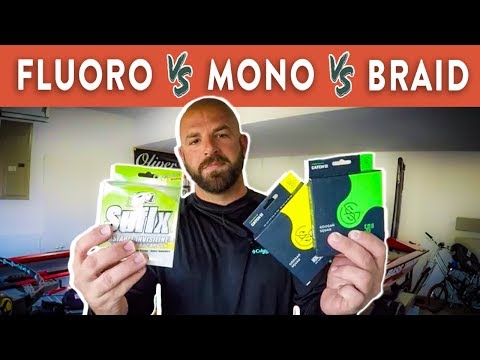When Should I Use Fluorocarbon Fishing Line?
Fishing Line Types 101 | When To Use Mono, Fluoro, Or Braid
Keywords searched by users: When should I use fluorocarbon fluorocarbon vs braid, what is fluorocarbon line good for, fluorocarbon vs mono, fluorocarbon fishing line 40lb, fluorocarbon leader, fluorocarbon fishing line 50lb test, fluorocarbon fishing line 15 lb, seaguar fluorocarbon
What Is Fluorocarbon Best For?
Fluorocarbon fishing line possesses a unique advantage due to its near-invisibility when submerged in water, making it exceptionally effective for targeting cautious and easily spooked fish species. In contrast, monofilament fishing line is more visible in water, making it a better choice for fishing in clear or shallow waters. This distinction between fluorocarbon and monofilament lines becomes particularly important when choosing the right fishing line for specific fishing conditions. On January 22, 2023, this information remains relevant to anglers looking to maximize their success on the water.
Should You Use Fluorocarbon As A Main Line?
Is fluorocarbon the right choice for your main fishing line? To fully harness the benefits of fluorocarbon, consider its application in various fishing scenarios. It excels when you’re angling in areas with heavy cover or rugged underwater structures, as its low visibility can help prevent spooking wary fish. Additionally, fluorocarbon is an excellent choice in clear water conditions where fish have sharp eyesight, such as trout. It’s also well-suited for pursuing large, toothy species. In freshwater environments, fluorocarbon-coated monofilament stands out as a versatile main line, particularly for targeting walleye and trout. Whether you’re fishing in a tranquil lake or a bustling river, understanding when and where to use fluorocarbon as your primary line can significantly enhance your angling success. [Published on June 18, 2021]
What Is The Downside To Fluorocarbon?
Fluorocarbon fishing line, while offering several advantages, also comes with its share of disadvantages. One of the key benefits of fluorocarbon is its exceptional sensitivity. Due to its composition, which is harder than monofilament, fluorocarbon lines transmit vibrations effectively, allowing anglers to detect even subtle movements or strikes underwater. However, there are some downsides to consider when using fluorocarbon. Knot failure can be a problem, as fluorocarbon lines can be prone to slipping or breaking when improperly tied. Additionally, they may be more susceptible to line breakage compared to other types of fishing lines. Another drawback is a decrease in shock resistance, which can affect the line’s ability to absorb sudden jerks or strong strikes from fish. To mitigate these cons, it’s crucial to use proper knot-tying techniques and handle fluorocarbon lines with care during fishing activities.
Categories: Top 13 When Should I Use Fluorocarbon
See more here: taomalumdongtien.net

Spoolable fluorocarbon is a great choice for a variety of presentations where low visibility, strength, hooksetting power and sensitivity are key. If near-zero stretch and ultra-thin line diameters are critical to the presentation, there’s no beating a superline.Fluorocarbon is practically invisible in the water, making it great for catching wary fish. Monofilament can be seen more easily, so it’s better suited to fishing in clear or shallow waters.To reap the advantages of fluorocarbon, use it when you plan on fishing around heavy cover, rough structure, clear water, large and toothy fish, and for fish with great eyesight like trout. For freshwater, fluorocarbon coated monofilament makes a great main line for many fish especially walleye and trout.
- Pros. Sensitivity – Because fluorocarbon is made from harder material than mono, the line transmits a greater level of vibration. …
- Cons. …
- Knot Failure. …
- Line Breakage. …
- Decreasing Shock Resistance. …
- Avoiding the Cons.
Learn more about the topic When should I use fluorocarbon.
- Why Use Fluorocarbon? – Berkley® Fishing US
- Fluorocarbon vs Mono: What’s the Best Leader Material?
- The Best Fluorocarbon Fishing Line for Leaders and Main Line
- The Pros and Cons of Fluorocarbon Line – Strike King
- Mono, Fluorocarbon, and Braided Fishing Lines – TripSavvy
- DAIWA FISHING TIPS: Straight to the point – Fishing with Fluorocarbon